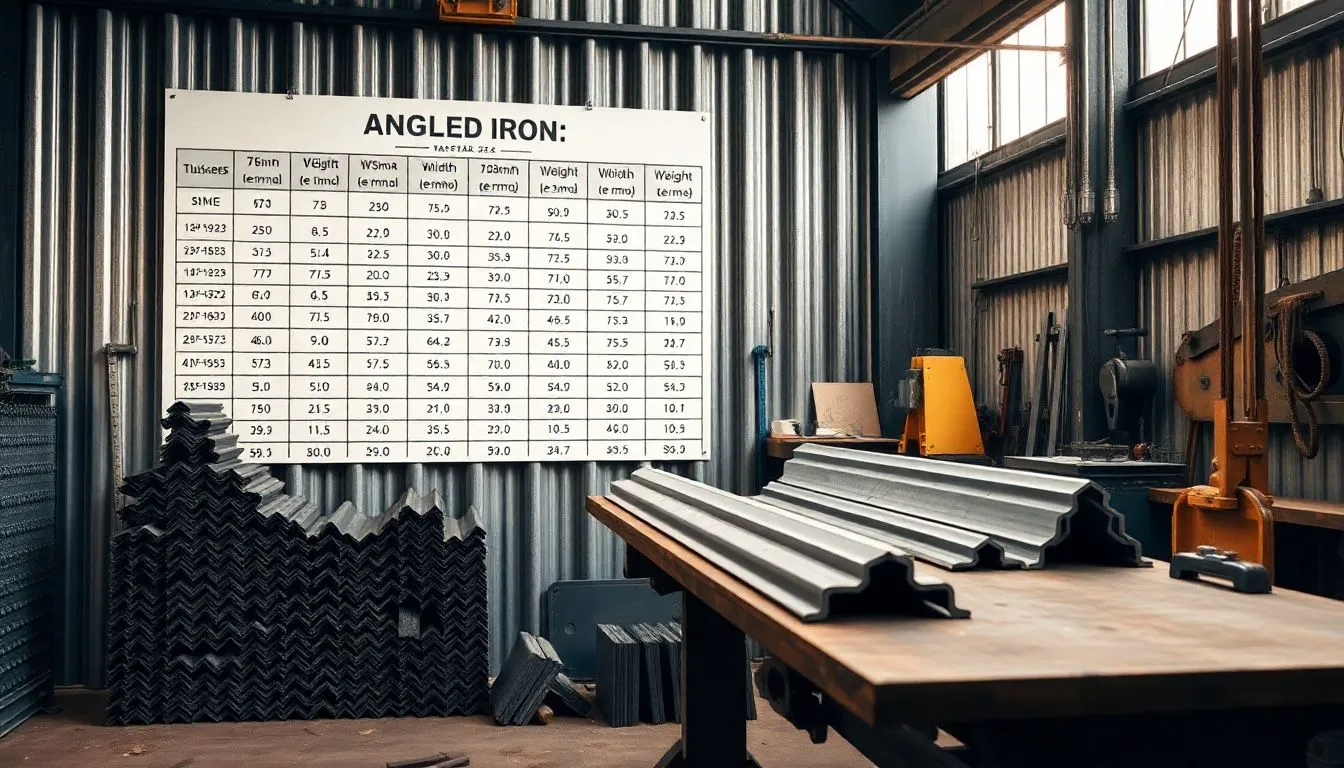Introduction
Choosing the right angle iron size can make or break a project. Whether you’re building a frame, a shelf, or a fence, getting the right dimensions and weight is key. Accurate measurements ensure safety, save money, and keep your project on track. This guide will help you understand standard sizes, how to read weight charts, and tips for selecting the best angle iron for your needs.
Understanding Angle Iron: Definition and Common Uses
What is Angle Iron?
Angle iron is a steel shape with two flat sides forming a 90-degree bend. It looks like an “L” and is used in many ways. It’s made from strong materials like mild steel or aluminum. Its shape makes it perfect for support and framing.
Typical Applications
Builders use angle iron to create strong frameworks, support shelves, or make machine parts. Fences, bridges, and furniture often feature it. For example, a small DIY project might include angle iron to build a sturdy workbench frame.
Types of Angle Iron
You’ll find two main types:
- Equal leg angles have sides of the same length.
- Unequal leg angles have sides of different lengths, ideal for specific shapes.
Use depends on whether the project needs strength, aesthetics, or both.
Standard Sizes of Angle Iron
Common Dimensions and Size Nomenclature
Size names usually describe leg lengths and thickness. For example, a 2x2x1/8″ angle iron has both legs 2 inches long with 1/8 inch thick. Standard sizes run from small (1x1x1/8″) to large (6x6x1/4″).
Industry Standards and Guidelines
Standard sizes follow rules set by organizations like ASTM (American Society for Testing and Materials) and AISC (American Institute of Steel Construction). These ensure consistency and safety.
Metric vs. Imperial Measurements
Some countries use millimeters, like 50x50x3 mm, instead of inches. If you’re working across regions, convert measurements carefully. Use online tools or charts to switch between systems without mistake.
Weight Chart for Angle Iron: Calculation and Key Data
How Is the Weight of Angle Iron Calculated?
Weight depends on the volume and the material’s density. The basic formula is:
Weight = Volume x Density
For angle iron, calculate the volume from its dimensions and multiply by the material density to find the weight.
Typical Weight Range by Size
| Size (Legs x Legs x Thickness) | Approx. Weight (kg/m) | Approx. Weight (lb/ft) |
|---|---|---|
| 1x1x1/8″ | 1.5 | 0.99 |
| 2x2x3/16″ | 3.2 | 2.12 |
| 3x3x1/4″ | 6.5 | 4.31 |
| 4x4x3/8″ | 10.8 | 7.16 |
| 6x6x1/2″ | 23 | 15.2 |
Density of Common Materials
- Steel: ~7.85 g/cm³
- Aluminum: ~2.70 g/cm³
Knowing material density helps you estimate weight faster and more accurately.
Practical Applications and Selection Tips
Choosing the Right Size and Weight
Pick your size based on what the angle iron will support. Think about the load, span, and safety margin. Use the weight chart to make quick guesses, but always double-check calculations.
Load-Bearing Capacity and Structural Considerations
The thicker and larger the angle iron, the more weight it can handle. For heavy-duty projects, size up. Smaller sizes work well for decorative accents or light supports.
Cost and Material Efficiency
Larger, thicker angles cost more but provide extra strength. To save, choose the smallest size that still meets your needs. This balances cost, weight, and strength.
Safety Precautions
Never underestimate the importance of properly sizing your angle iron. Under-sized support can cause failures, while oversized support can be unnecessarily heavy and expensive. Follow safety standards and engineering guidance.
Tools and Resources for Accurate Sizing and Weight Estimation
Digital Tools and Calculators
Use our Angle Weight Calculator to quickly determine weights based on size and material type.
Reference Materials and Charts
Manufacturers and steel suppliers offer downloadable angle iron weight charts. Use these during planning to avoid surprises.
Consulting Professionals
For complex builds, consult an engineer. Their expertise ensures your selections are safe and meet load demands.
Conclusion
Getting the right angle iron size and weight shapes your project’s success. Always rely on trusted charts and calculations to choose the best fit. Accurate data keeps your work safe, efficient, and cost-effective. Proper sizing isn’t just about saving money—it’s about building something that lasts. Double-check measurements and follow standards before you buy or start construction.
FAQs
What is angle iron used for in construction?
It’s used to support structures like shelves, bridges, and frames.
How do I calculate angle iron weight?
Use the formula: volume x density. Or use an online weight calculator.
What’s the difference between equal and unequal leg angles?
Equal leg angles have sides of the same length. Unequal leg angles have one longer side.
How do I convert angle iron sizes from imperial to metric?
Use conversion tools: 1 inch = 25.4 mm. Carefully match thickness as well.
Where can I buy angle iron?
Available at most local steel suppliers or online through platforms like McMaster-Carr.

